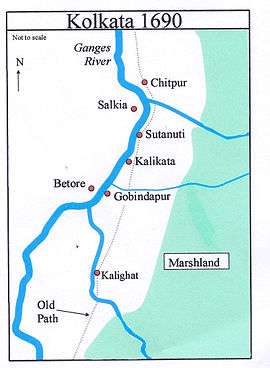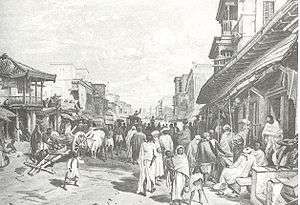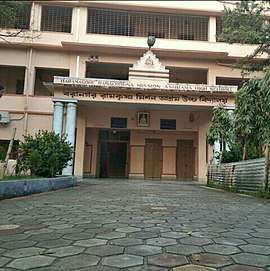Sutanuti
Sutanuti was one of the three villages which were merged to form the city of Kolkata (formerly Calcutta) in India. The other two villages were Gobindapur and Kalikata. Job Charnock, an administrator with the British East India Company is traditionally credited with the honour of founding the city. He settled in the village of Sutanuti.

In addition to the three recognised hamlets around which the city has grown up, must be added at least four others as the elementary constituents of the city (including Howrah on the opposite bank.) These are Chitpur, Salkia, Kalighat and Betor. Out of these four Betor, which was the focus of trade once upon a time, vanished in the seventeenth century. It was located around where Shibpur presently is.[1]
Location
"The three villages may be said, roughly speaking, to have extended along the river from Coolie Bazar, where the buildings of the Commissariat now stand in the vicinity of Prinsep’s Ghat, to Chitpore: but the English settlement proper was a very small affair indeed. It was confined to the locality between Baboo Ghat, hard by modern Eden Gardens, and a point about a hundred yards to the north of Clive Street. Surrounding it was the native portion of ‘Dhee’ Kolkata, and to the north was Suttanuttee. On the south stood Govindpore, high on the river-bank and covered with thick jungle. The total amount of inhabited land was only 840 bighas, or one-sixth of the territory conveyed by the sanad of Azim-us-shan and of this 204 bighas was absorbed by the Settlement itself, and 400 by the great Bazar to its immediate north. In Colonel Mark Wood’s Map of 1784, published in 1792 by William Baillie, Suttanuttee is described as extending from Chitpore in the north to what is designated in the map as Jora Bagan Ghat, a little below Nimtollah Ghat. Thence commenced the northern boundary of ‘Dhee’ Kolkata, and that village proceeded south as far as Baboo Ghat. Here Govindpore began and ended at the Govindpore Creek, afterwards called Surman’s Nullah and later Tolly’s Nullah."[2]
Mughal period
At the end of the fifteenth century a poem in praise of the serpent-goddess written by Bipradas Pipilai gives us the first authentic glimpse of the area. Satgaon or Saptagram on the west bank of the Hooghly, between Bandel and Tribeni was a great port. Lower down the river, on the same bank, Betor was a large market town, where travellers paused to buy provisions and worship the goddess Chandi. Chitpur and Kalikata were neighbouring villages passed just before reaching Betor. Gobindapur and Sutanuti did not exist. Kalighat was a small sanctuary claiming just a bare mention.[1] When the Portuguese first started to frequent Bengal, around the year 1530, the two great centres of trade were Chittagong, then known as Porto Grande or Great Haven, in the east and Satgaon, then known as Porto Pequeno or Little Haven in the west. Tolly’s Nallah or Adi Ganga was then the outlet to the sea and ocean-going ships came up to around where Garden Reach presently is, then the anchoring place for ships. Only country boats operated further up the river.[1] Possibly the Saraswati river was another watery life line. It started drying up from the middle of the sixteenth century. The Portuguese built a new port at Hugli in 1580.[3]

Towards the end of the sixteenth century, the merchant-princes of Port Pequeno were forced to seek another market for their trade. Most of them settled down in Hugli but four families of Bysacks (an English corruption of the Indian term Vaishakh) and one of Setts (an English corruption of the Indian surname Seth), determined to profit by the growing prosperity of Betor, founded the village of Gobindapur, on the east bank of the river. On the northern side of Dhee (meaning village or group of villages) Kalikata (as Calcutta was known in Bengali), came up a place for sale of cloth, which was soon to become celebrated as Sutanuti Haat, the cotton bale market. In 1596, the place is noticed as a district of the Sirkar (or government) of Satgaon, in the book Ain-e-Akbari of Abul Fazal, the prime minister of Akbar. As traders, the Portuguese were succeeded by the Dutch and finally the British came.[1]
The British arrive
Job Charnock is heard of in various positions and places associated with the East India Company from around 1658. After Cossimbazar and Patna he stayed for shorter periods at Hughli, Hijli and Sutanuti. He was convinced about the advantages of Sutanuti as a place of settlement but his colleagues and superiors were not. However, the officials in Madras, after certain debacles at Chittagong, allowed him, with the objective of establishing a settlement, to sail for Sutanuti and he landed there on 24 August 1690, a date that has become historically famous. He lived for two and half years after that.[4]
Job Charnock favoured Sutanuti as a settlement because of the security of the location. It was protected by the river on the west and by impassable marshes on the south and the east. Only the north had to be guarded.[5]
The three villages were part of the khas mahal or imperial jagir (an estate belonging to the Mughal emperor himself), whose zamindary rights were held by the Sabarna Roy Choudhury family of Barisha. On 10 November 1698, Job Charnock’s successor and son-in-law, Charles Eyre, acquired the zamindary rights for the three villages from the Sabarna Roychoudhuris. The company paid regular rent to the Mughals for these villages till 1757.[6]
Kolkata emerges as a city
Grew a City
As the fungus sprouts chaotic from its bed
So it spread
Chance-directed, chance-erected, laid and built
On the silt
Palace, byre, hovel – poverty and pride
Side by side
And above the packed and pestilential town
Death looked down.[7]
Rebellions and skirmishes in the hinterland gave the English the pretext to fortify Kolkata. The fort was named Fort William after William of Orange who was at that time both king of both England and stadtholder of part of the Dutch Republic. Kolkata soon grew into a prosperous town. It attracted merchants, skilled artisans, adventurers and law-abiding citizens anxious to flee from the lawless conditions in the neighbouring territories. In 1700, Kolkata was separated from Madras and became a new presidency. The three presidencies at Kolkata, Mumbai and Chennai started functioning independently. In 1717, it secured from the Mughal emperor Farrukhsiyar, certain concessions regarding trade and revenue. It helped the company to grow commercially.[5]
Siraj ud-Daulah, the Nawab of Bengal was alarmed by the growing prosperity and enhanced fortifications of Kolkata. In 1756, he decided to attack Kolkata. After capturing Kolkata, Siraj ud-Daula named it Alinagar, after his grandfather Alivardi Khan. The name of Kolkata was restored in 1758, after the British regained control of Bengal. "To the English indeed, the sack of Kolkata must have appeared little short of devastation. But in fact, of the four contiguous villages of Gobindapur, Kalikata, Sutanuti and Chitpur, only Kalikata or ‘White’ Calcutta suffered extensively… The Black Town escaped major damage, except the burning down of Barabazar… Gobindapur had been fired by the English themselves." The English evacuees set up temporary quarters at Falta, some 40 miles (64 km) downstream. What followed was a series of skirmishes finally leading to the Battle of Plassey on 23 June 1757 and the establishment of British power in Bengal.[8]
Black town
There were practically no roads in the area except the road connecting Halisahar in the north to Kalighat in the south (it was up to Barisha according to some). Some writers called it pilgrim path. It was kept in repair by the Sheth family; Jagannath Sheth planted trees on both sides of it. The Sheths also maintained a road connecting their garden house at Jorabagan with old Fort William. Some road construction started in 1721 but most of roads came up after 1757.[9]
As the city grew, different neighbourhoods sprang up. Mechhuabazar (later Jorasanko) was the fish market. Kalutola was home of the Kalus (Kaluas) or oil pressers of the company, who may have supplied mustard and other oils to the merchants. Kumortuli was named after the Kumors (Kumbhars) or potters who settled there. Jorabagan, also called Sheth Bagan in earlier days had a 110 bigha garden owned by the Sheths. Further north there were the settlements Bagbazar and Shyambazar. The area was citadel of Bengali aristocracy. Bosepara was set up by Basus and Pals migrating from Hooghly district. Nidhuram Bose is believed to have arrived before the British came to Sutanuti. Sometimes localities were named after trees. Bartala was named after twin banyan trees (bar or bat). Taltala was named after its tal (palmyra) trees. In those days areas such as Entally were part of the salt lakes, Ballygunj and Rasapagla (later Tollygunj) were sleepy villages.[10]
The three-mile (5 km) Maratha Ditch was excavated by 1742 as a protections against the marauding Marathas (known in Bengal as Bargis), but they never came and Siraj ud-Daulah easily crossed it with his forces, near what is now Sealdah. At around the same time, the palisades around the English settlement were strengthened, creating in effect a ‘white ghetto’.[11]
Long before Siraj-ud-dowla sacked Kolkata, the psychological barrier sprung up with a clear distinction between the ‘White Town’ restricted mostly to the north of the old fort and ‘Black Town’ spread over Sutanuti, Chitpur and Gobindapur. The sharp division was sealed by the gradual withdrawal of the British from Sutanuti.[11] Even a deep trench, 16 to 18 feet (5.5 m) wide, was dug in 1710, ostensibly to drain the White Town but also to separate it from the Black Town in Sutanuti.[12] Even as the English gradually abandoned Sutanuti as a place of abode, there stood at its northern most corner a pleasure resort called Perrin’s Garden, where "once it was the height of gentility for the Company’s covenanted servants to take their ladies for an evening stroll or moonlight fete." It also gradually fell out of use and repair and was sold out in 1752.[13] With the commencement of construction of the new Fort William, in 1758 and the demolition of Gobindapur, the inhabitants were compensated and given land in Taltala, Kumortuli and Shobhabazar. European inhabitants gradually forsook the narrow limits of the old palisades and moved to around the Maidan.[14]
Sett and Basaks
Before the British came the most powerful families in the region were Sheths and Basacks, the merchants of yarn and cloth market at Sutanuti. With the arrival of the British these families flourished with renewed vigour. Janardan Sheth was a trading agent of the British. Shobharam Basack (1690–1773) became a millionaire by supplying textiles to East India Company.[15]
The earliest names floating around are those of Mukundaram Sheth, who lived in the earlier part of sixteenth century and moved from Saptagram to Gobindapur. When Gobindapur was demolished the Sheths moved to Sutanati Haat or Barabazar. Thereafter, the most important name is that of Janardan Sheth. He was the son of Kenaram Sheth (Kiranchandra Sheth according to some) and had two brothers, Baranasi and Nandaram. Janardan Sheth’s son Biashnabcharan Sheth had a roaring business of selling bottled Ganges water.[16]
The Marwaris ousted the Sheths and Basacks as cloth merchants and changed the name of old Sutanuti haat or market to Barabazar.[10] Even after that some of them continued to have business ties. Radhakrishna Basak (d. 1811), descendant of Shobharam Basak was Dewan of the Bank of Bengal, but the leading business families of the eighteenth century switched to investments in urban property. While Shobharam Basak left thirty-seven houses to his heirs. Ramkrishna Sheth left sixteen in Barabazar alone.[17] The Sheths and the Basacks began to decline from the mid-eighteenth century – just as Kolkata began to grow into a large city.[15]
Along with the Sheths and Basaks, Sutanuti gradually lost its visibility, replaced by numerous neighbourhoods, and retreated into the books of history and scrolls of honour. We hear of Nabakrishna Deb being offered the Talukdari of Sutanuti.[18] Binay Ghosh, the renowned cultural-historian has distinguished four types of culture prevailing in old Kolkata – Sutanuti culture, Kalikata culture, Gobindapur culture and Bhawanipur culture. Sutanuti culture was the urban-feudal culture propagated by Nabakrishna Deb, Kalikata culture was the mercantile culture propagated by Sheths-Basaks. Gobindapur culture was the European nouveaux riche culture. Bhawanipur culture was the Hindu Bengali middle-class culture.[15] Sutanuti is the place where Job Charnock landed in 1690. Around it grew not only the city of Kolkata but also the mighty British Empire in India. As the heart of Kolkata’s Black Town, as well as cradle of its culture, Sutanuti continues to hold nostalgic curiosity for anybody with an interest in old Kolkata.
See also
- European colonies in India
References
- Cotton, H.E.A., Calcutta Old and New, 1909/1980, pp. 1-4, General Printers and Publishers Pvt. Ltd.
- Cotton, H.E.A., p.17.
- Patree, Purnendu, Purano Kolkatar Kathachitra, (a book on History of Calcutta), (in Bengali), first published 1979, 1995 edition, p.71, Dey’s Publishing, ISBN 81-7079-751-9.
- Biswas, Prabodh, Job Charnock, in Calcutta, the Living City, Vol I, edited by Sukanta Chaudhuri, pp. 6-7, Oxford University Press, ISBN 0-19-563696-1
- Sengupta, Nitish, "History of the Bengali-speaking People", 2001/2002, pp.123-124, UBS Publishers’ Distributors Pvt. Ltd., ISBN 81-7476-355-4
- Nair, P.Thankappan, The Growth and Development of Old Calcutta, in Calcutta, the Living City, Vol I, pp. 10-12
- Quoted by Geoffrey Moorhouse in Calcutta: the City Revisited, 1971, Penguin Books, p 31.
- Sinha, Pradip, Siraj’s Calcutta, in Calcutta, the Living City, Vol I, pp. 8-9
- Bagchi, Amiya Kumar, Wealth and Work in Calcutta 1860–1921, in Calcutta, the Living City, Vol I, p. 229.
- Nair, P. Thankappan, The Growth and Development of Old Calcutta, in Calcutta, the Living City, Vol I, pp. 11-18.
- Lahiri Choudhury, Dhriti Kanta,Trends in Calcutta Architecture, in Calcutta, the Living City, Vol I, pp. 156-157.
- Nair, P. Thankappan, Civic and Public Services in Old Calcutta, in Calcutta, the Living City, Vol I, p. 227
- Cotton, H.E.A., p. 34.
- Cotton, H.E.A., p. 72.
- Deb, Chitra, The ‘Great Houses’ of Old Calcutta, in Calcutta, the Living City, Vol I, pp. 56-60.
- Patree, Purnendu, p. 135-139.
- Bhattacharya, Sabyasachi, Traders and Trades in Old Calcutta, in Calcutta, the Living City, Vol I, P. 206.
- Raychoudhuri, Subir, The Lost World of the Babus, in Calcutta, the Living City, Vol I, P. 72.
